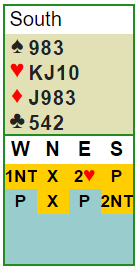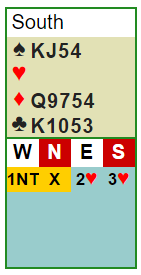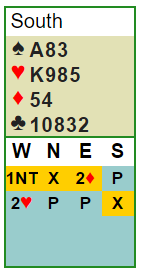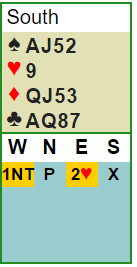
Source: Taming the Weak Notrump, part 2 By Steve Weinstein and Adam Kaplan Feb. 8, 2013
In Part 1, we covered what to do after they opened a weak notrump, partner doubled for penalty, and 3rd hand passed or redoubled. We now discuss our structure after 3rd hand makes a bid.
When the opponents bid in 3rd hand: 2 or lower (Natural)
or lower (Natural)
Passes set up a force through 2 (they cannot play 2
(they cannot play 2 or lower undoubled), the first double by our side is takeout, and both hands should avoid doubling with a void in their suit. After our side has made one takeout double, later doubles are penalty: Direct penalty doubles show 4+ cards in their suit, while balancing penalty doubles are more cooperative and show 3+ cards in their suit.
or lower undoubled), the first double by our side is takeout, and both hands should avoid doubling with a void in their suit. After our side has made one takeout double, later doubles are penalty: Direct penalty doubles show 4+ cards in their suit, while balancing penalty doubles are more cooperative and show 3+ cards in their suit.
If we make a forcing pass, it shows either a hand without clear direction or a penalty pass. If the strong hand reopens with double, once advancer fails to pass, they must have a hand without clear direction: 2NT is natural, non-jumps are non-forcing, and a cuebid is a general force.
 2
2 natural
natural
If the strong hand reopens with something other than double, we pass with very weak hands, 2NT is natural, new suits are forcing, and a cue-bid is a general force.
For hands with direction, we bid immediately and mostly naturally in 4th hand. An issue in these auctions is having only one way to make a 3-level bid; we want to judge our game prospects accurately, and we resolve this by playing Lebensohl. This gives us two ways to bid on the 3-level, while only sacrificing a direct natural 2NT. We can usually pass and bid a natural 2NT later.
Direct bids at the 2-level are non-forcing and natural. At the 3-level, there are three important hand-types to show: forcing, invitational, and competitive. When we have a natural bid available on the 2-level, we can accomplish all three: Compete on the 2-level, invite by bidding 2NT followed by 3 of our suit, and force by making a direct 3-level bid.
When we do not have a 2-level bid available, even with Lebensohl, we only have 2 ways to bid on the 3-level. In favor of showing forcing and competitive hands, we choose to give up showing the invitational hand; when we have the invitational hand, we either overbid or underbid slightly.
 2NT = Lebenshol, 3
2NT = Lebenshol, 3 forzado a no ser que tenga extras
forzado a no ser que tenga extras
Facing 15+ HCP, this hand isn’t enough to game-force, but is more than a competitive 2 .
.
A direct cue-bid shows a forcing offensive hand with shortness in the opponent’s suit; this is a hand unsuitable for a takeout double. Bidding 2NT then cue-bidding shows a forcing hand with a stopper and 5+ cards in a major. X: penalty 15 PH+
X: penalty 15 PH+
This is a textbook hand for a direct cue-bid: We have a 3-suited hand, enough to GF, and cannot double because of the heart void.
When the opponents play “Systems On” or 2-Suited Runouts
After Stayman by 3rd hand, double shows values and creates a penalty double situation, and other bids are natural, using the same Lebensohl structure we discussed.
After a transfer by 3rd hand, we gain a few extra bids. Since we “know” what bid to expect from the 1NT opener, we can use this to our advantage: Pass is still forcing, and 2NT and higher remain the same, but we use the 2-level “cue-bid” as a replacement for a takeout double, and use a double to show values. Double followed by double shows a 3-card penalty double, while pass then double shows a 4-card penalty double in the suit shown by the transfer
.

2 transfer to heart; X+ cards penalty 2
transfer to heart; X+ cards penalty 2 transfer to spade
transfer to spade
After a 2-suited bid by 3rd hand, if they are bidding one of their suits, double is takeout of that suit, and other bids are natural. If they are not bidding one of their suits, double creates a penalty double situation, and other bids are natural
.

2 reds 2
reds 2 majors
majors
When the opponents bid in 3rd hand: 2 or higher
or higher
If the opponents bid 2 , we are not in a force. Doubles are card-showing. Due to the limited space and non-forcing auction, we can no longer pass with values; as a result, double no longer is takeout, and instead shows general values.
, we are not in a force. Doubles are card-showing. Due to the limited space and non-forcing auction, we can no longer pass with values; as a result, double no longer is takeout, and instead shows general values.
Since we still need to be able to distinguish between weaker and stronger hands, we use the same Lebensohl structure over 2 as discussed before. Direct bids are forcing, while bidding 2NT first then a 3-level bid is non-forcing but constructive.
as discussed before. Direct bids are forcing, while bidding 2NT first then a 3-level bid is non-forcing but constructive.  2
2 to play; X take out
to play; X take out
A direct 2NT followed by 3 would show a constructive hand — This hand is not good enough for that auction, and must pass over 2
would show a constructive hand — This hand is not good enough for that auction, and must pass over 2 and bid 3
and bid 3 over partner’s reopening double.
over partner’s reopening double.
When the opponents bid 2NT or higher, we use the same card-showing doubles as over 2 , but we no longer have the luxury of using Lebensohl. Here, with only one way to bid on the 3-level, we choose to sacrifice the weaker hands in favor of avoiding jumping with the stronger ones. Bids on the 3-level are forcing, and weaker hands must pass. We miss competing with this treatment, but in turn gain accuracy in our game-bidding.
, but we no longer have the luxury of using Lebensohl. Here, with only one way to bid on the 3-level, we choose to sacrifice the weaker hands in favor of avoiding jumping with the stronger ones. Bids on the 3-level are forcing, and weaker hands must pass. We miss competing with this treatment, but in turn gain accuracy in our game-bidding. 3
3 = preemptive
= preemptive
Although this hand isn’t fully worth a game-force, it is simply too good to pass. This illustrates the problem with only having one way to bid on the 3-level. Given the choice between forcing and passing, we prefer to “round up”, therefore, we would bid 3 and hope for the best.
and hope for the best.
Doubling in 4th seat after partner passes and 3rd seat passes over 1NT
In balancing position over 1NT, we use the same methods as in direct seat, however balancing bids can be slightly lighter (Double is 13+ or so). Advancer should still run from 1NT doubled with fewer than 5 HCP, and the first double by either partner after the balancing double is takeout. Most importantly, after a 4th seat double, a force through 2 is set up ONLY if 2nd hand is able to show strength. Showing strength is defined as either passing 1NT-X for penalty, or by making a takeout or penalty double.
is set up ONLY if 2nd hand is able to show strength. Showing strength is defined as either passing 1NT-X for penalty, or by making a takeout or penalty double.
Doubling in 4th seat after partner passes and 3rd seat bids over 1NT
Despite lead-directional doubles being the optimal treatment over responder’s artificialbid when they play a strong NT, and a reasonable treatment when they play a weak NT, we believe it is more valuable to use double as a strong hand over a weak NT, since we would be stuck for a bid otherwise. Double shows roughly the equivalent of the values needed for a direct-seat penalty double.
 2
2 = transfer
= transfer
On the other hand, when responder’s bid is natural, we prefer double to be takeout. Although there are hands where a values double would work better, we feel that you are more likely to want to compete when your hand is short in their suit. When you have a hand that does not fit a takeout double, your partner can still balance if he is short.
 2
2 = to play
= to play
Responder’s bid is natural, so your double would be takeout. Double, bringing every suit into play.
 2
2 = to play
= to play
Responder’s bid is natural, so your double would be takeout. So you must pass with this hand. A stronger hand might chance a double.
It doesn’t matter if 4th hand’s double is values or takeout, our responses to it use 2NT as Lebensohl, with corresponding meanings for new suits (2-level = non-forcing, 3-level = forcing). If 1st hand bids, then the first double by our side is card-showing, and later doubles are penalty. Once again, in auctions where 4th seat is the initial doubler, we are only in a force through 2 if 2nd hand is able to show strength, either by passing the double for penalty, or by making a card-showing double of 1st hand’s rebid.
if 2nd hand is able to show strength, either by passing the double for penalty, or by making a card-showing double of 1st hand’s rebid.
 2
2 = transfer to spades, X = values
= transfer to spades, X = values
After partner’s value-showing double, we can bid a forcing 3 thanks to Lebensohl.
thanks to Lebensohl.
Summary
Here is a summary of our methods after a weak NT (minimum good 13 or worse) and double:
1NT (Dbl) = 15+ HCP, could be unbalanced
- Pass or Redouble
- PASS = no clear direction, usually 5+ HCP, sets up forcing pass through 2

- 2
 = artificial, 0-4 HCP, no 5-card spade/heart/diamond suit
= artificial, 0-4 HCP, no 5-card spade/heart/diamond suit
- With 0-3 clubs, doubler should pull to a 5-card suit, or their cheapest 4-card suit.
- 2
 = natural, 5+ diamonds, 0-4 HCP
= natural, 5+ diamonds, 0-4 HCP - 2
 = natural, 5+ hearts, 0-4 HCP
= natural, 5+ hearts, 0-4 HCP - 2
 = natural, 5+ spades, 0-4 HCP
= natural, 5+ spades, 0-4 HCP - 2NT = artificial, GF two-suiter (5-5 or better)
- Doubler bids 3-card suits up the line, or 3
 to show long spades
to show long spades
- Doubler bids 3-card suits up the line, or 3
- 3 any = natural, GF one-suiter
- PASS = no clear direction, usually 5+ HCP, sets up forcing pass through 2
- 3rd hand bids 2
 , 2
, 2 , or 2
, or 2 (natural)
(natural)
- PASS = no clear direction, sets up force through 2
 , first double is takeout
, first double is takeout - DOUBLE = takeout (not with a void), sets up force through 2

- 2
 = natural (5+), non-forcing
= natural (5+), non-forcing - 2
 = natural (5+), non-forcing
= natural (5+), non-forcing - 2
 = natural (5+), non-forcing
= natural (5+), non-forcing - 2NT = artificial (lebensohl), relay to 3

- Doubler may break the relay to make a natural bid, showing a hand too good to overcall
- 3

- new suit lower than 3rd hand’s = to play (no invite available)
- new suit higher than 3rd hand’s = natural and invitational to game
- cue-bid = artificial, forcing, shows a stopper and an unbid 5-card major
- cue-bid = GF, shortness in their suit, offensively-oriented (void or strong offense)
- new suit at 3-level = natural (5+), forcing
- PASS = no clear direction, sets up force through 2
- 3rd hand bids 2
 , 2
, 2 , or 2
, or 2 conventionally
conventionally
- If 3rd hand’s bid promises length in the suit bid and could be passed
- DOUBLE = takeout and sets up a force through 2
 (subsequent doubles penalty)
(subsequent doubles penalty) - PASS = no clear direction, sets up force through 2
 , first double is takeout
, first double is takeout - bids = natural, non-forcing
- DOUBLE = takeout and sets up a force through 2
- If 3rd hand’s bid does not promise length
- DOUBLE = values and sets up a force through 2
 (subsequent doubles penalty)
(subsequent doubles penalty) - PASS = failure to show cards, implied weakness, we are NOT in a force
- DOUBLE and DOUBLE of a transfer = 3-card penalty double
- PASS then DOUBLE of a transfer = 4-card penalty double
- DOUBLE = values and sets up a force through 2
- If 3rd hand’s bid promises length in the suit bid and could be passed
- 3rd hand bids 2
 or higher
or higher
- We are not in a force
- PASS = weak hand, no clear direction
- DOUBLE = values
- 2NT = artificial (lebensohl) relay to 3
 (as above)
(as above) - new suit at 3-level = natural (5+), forcing [even if there is no room to Lebensohl]
1NT (P) P (Dbl)
- Same as direct except DOUBLE only promises 13+ HCP
- Advancer still passes with 5+ HCP and runs with 0-4 HCP.
- first double = takeout
- Only a penalty pass of 1NT-X or a double sets up a forcing pass through 2

1NT (P) bid (Dbl)
- DOUBLE = values (15+) if bid is ART, takeout (13+ support points) if bid is natural
- 2NT = artificial (lebensohl), relay to 3
 (as above)
(as above) - new suit at 2-level = to play
- new suit at 3-level = natural (5+), forcing
- first double = card-showing
- Only a penalty pass or card-showing double by 2nd hand sets up a forcing pass through 2

- 2NT = artificial (lebensohl), relay to 3
You will find that this structure after the penalty/cards double makes the weak notrump far less effective against you. Soon, you will be hoping for your opponents to open them!
Esta entrada también está disponible en: Spanish

